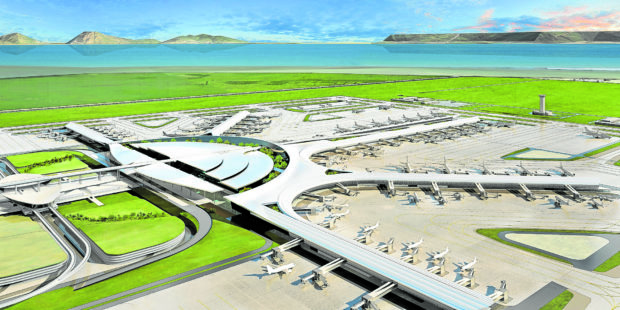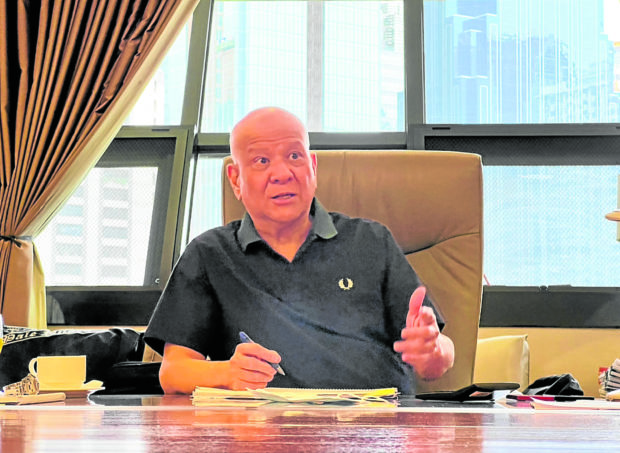World-class ‘aerocity’ rising

DREAMGATEWAY Exterior design of SMC’s P740-billion New Manila International Airport in Bulakan, Bulacan, the single most expensive infrastructure project in Philippine history. —CONTRIBUTED PHOTOS
Ramon S. Ang is never out of new ideas, especially when it comes to expanding the business and economic footprint of one of the country’s largest conglomerates, which he heads.
When we sat down for an interview recently, however, the president and CEO of San Miguel Corp. (SMC) seemed more focused than usual on one particular project—one mega project which, by his own admission, will only start making money two decades after its completion.
At a total projected cost of P740 billion ($13.5 billion)—to be financed solely by the company without a single centavo of funding from the government—the new Manila International Airport in Bulakan, Bulacan, is the most expensive infrastructure undertaking in the country’s history whether by a public or private entity.
“This is a legacy project that will benefit millions of travelers and give the economy a big boost in terms of job creation and economic growth,” he says. “And if you’ve seen the [architectural] plans, you’ll know that this airport is something we can all be proud of as Filipinos.”
Currently being built on 2,500 hectares of coastal land along Manila Bay, the airport will have a total of four parallel runways once completed, two on each side of a sprawling terminal building that will have a total of one million square square feet under one massive roof.
Iconic airport design
The structure, Ang says, will rival those of of Hong Kong and Singapore and put the country on the global map in terms of iconic airport designs.
From an operational perspective, it will also improve the overall airport experience of travelers who currently have to spend, on bad days, as long as two hours to negotiate the entire check-in and immigration processes at the existing Ninoy Aquino International Airport (Naia).
Ang says he personally supervised the design of the terminal building, including the main departure area driveway that will be 12-lane wide, to accommodate as many as 240 vehicles at one time, which will unload passengers onto a 15-meter wide sidewalk where their luggage will be prescreened.
“The security screening will start at that point when your luggage is still outside,” he says, explaining that roving bomb-sniffing dogs will be used to isolate for closer inspection luggage items that could pose a security risk even before they are brought into the terminal building.
“With the technology we’re putting in, including preclearing travelers 24 hours before, you will be able to complete check-in and clear immigrations a few minutes after entering the building,” he adds.
The ongoing construction phase (30 percent of land development has been completed) will create direct and indirect employment for an estimated 1 million workers from Bulacan and the surrounding provinces.
At full capacity, the airport will be able to efficiently facilitate the movement of up to 100 million travelers each year in comfort. In contrast, the latest peak capacity of Naia—while almost exploding at the seams —was 47 million passengers before the outbreak of the pandemic.
Is he worried about efforts to develop Clark International Airport or Sangley Point as alternative aviation gateways to Manila?
Ang shrugs off the threat, saying there remains no concrete plan for Sangley Point, while Clark is 110 kilometers away from the capital.
“But the Bulacan airport is only 22 kilometers away from Rizal Park,” he notes, adding that a plan to extend Roxas Boulevard further northward along the Manila Bay coastline will cut travel time to less than 20 minutes between the “aerocity” and the metropolis.
If plans don’t miscarry, the new airport with its first two runways will be operational by 2026.
Build, build, build
While all this is happening, Ang is also juggling other parts of the vast San Miguel empire to ensure that they will continue growing during what many business observers expect to be challenging economic times ahead for the country.
One particular business he is deeply involved in is the conglomerate’s new $1-billion battery storage venture that is aimed at improving the country’s energy sector by providing additional electricity during peak hours.
Under the scheme, San Miguel is building battery storage facilities around the country capable of storing as much as 1,000 megawatts of electricity that will be released into the grid during times of heightened demand, usually four hours in the morning and four hours in the evening.
“During off-peak hours, these batteries are recharged and the stored electricity will again be released during peak hours,” Ang says, explaining that the venture is profitable because electricity is sold at an average of P10 per kilowatt hour during peak demand and can be bought [for recharging the batteries] at P4 per kilowatt hour during times of the day when demand is low.
Ang is also focused on completing San Miguel’s Metro Rail Transit (MRT) Line 7 project a P77-billion undertaking—at the soonest possible time to take advantage of the upturn in economic activity as the pandemic wanes.
“Initially, we will be able to accommodate 350,000 commuters per day between Quezon City and San Jose del Monte [in Bulacan], but this will rise to 800,000 per day once the MRT-7 is fully operational,” he says, adding that test runs are expected to begin before 2022 is out.
Ang says he has other plans for the conglomerate on the drawing board but demurs to reveal them just yet, noting that his business rivals are often eager to either copy his ideas or mobilize opposition against them.
“So we’ll just stay quiet for now and work hard on these existing ones,” he adds with a chuckle.
That hard work seems to be paying off as the conglomerate is expected to return to its groupwide revenue level of P1 trillion by the end of the year—an amount not seen since before the outbreak of the pandemic—thanks to the strong performance of San Miguel Food and Beverage and Petron Corp.
“Globally, it’s a challenging time for everyone, but we’re ready for it.” INQ


